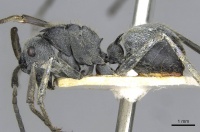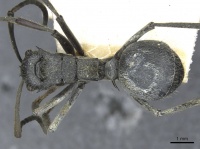Polyrhachis wellmani
| Polyrhachis wellmani | |
|---|---|

| |
| Scientific classification | |
| Kingdom: | Animalia |
| Phylum: | Arthropoda |
| Class: | Insecta |
| Order: | Hymenoptera |
| Family: | Formicidae |
| Subfamily: | Formicinae |
| Tribe: | Camponotini |
| Genus: | Polyrhachis |
| Subgenus: | Myrma |
| Species group: | militaris |
| Species: | P. wellmani |
| Binomial name | |
| Polyrhachis wellmani Forel, 1909 | |
The biology is not known but its close resemblance and therefore affinities with Polyrhachis schistacea suggests they have similar life histories.
Identification
A member of the Polyrhachis militaris species-group. Bolton (1973) - This species is so closely related to Polyrhachis schistacea that it would have been synonymized had it not been for a single character which appears to be consistent, namely the lack of lateral petiolar teeth. In size wellmani lies towards the lower end of the schistacea range and it may be that a more detailed investigation of smaller schistacea specimens will show a gradual diminution of ·the lateral petiolar teeth until a wellmani-like condition is reached.
Keys including this Species
- Key to Afrotropical Polyrhachis species (Bolton 1973, OUTDATED)
- Key to Afrotropical Polyrhachis species
Distribution
Distribution based on Regional Taxon Lists
Afrotropical Region: Angola (type locality), Democratic Republic of Congo, Zambia.
Distribution based on AntMaps
Distribution based on AntWeb specimens
Check data from AntWeb
Countries Occupied
| Number of countries occupied by this species based on AntWiki Regional Taxon Lists. In general, fewer countries occupied indicates a narrower range, while more countries indicates a more widespread species. |

|
Estimated Abundance
| Relative abundance based on number of AntMaps records per species (this species within the purple bar). Fewer records (to the left) indicates a less abundant/encountered species while more records (to the right) indicates more abundant/encountered species. |

|
Biology
Castes
Nomenclature
The following information is derived from Barry Bolton's Online Catalogue of the Ants of the World.
- wellmani. Polyrhachis wellmani Forel, 1909b: 68 (w.) ANGOLA. Combination in P. (Myrma): Wheeler, W.M. 1922a: 1004. See also: Bolton, 1973b: 323.
Unless otherwise noted the text for the remainder of this section is reported from the publication that includes the original description.
Description
Worker
Bolton (1973) - Tl 8.3-8.7, HL 2.22-2.37, HW 1.74-1.85, CI 78, SL 2.74-2.81, SI 152-157, PW 1.40-1.48, MTL 2.92-3.00. (3 measured.)
Very similar to Polyrhachis schistacea. Clypeus with a more or less distinct, truncate lobe, the anterior margin of which has numerous notches from which stout hairs arise. Eyes convex; sides of head in front of eyes convex. Alitrunk marginate laterally throughout its length, interrupted at the sutures. Pronotum armed with a pair of long spines, propodeum with a pair of short, thick upcurved teeth. Promesonotal suture distinct; metanotal groove impressed. Petiole with only a single pair of spines, situated at the dorsolateral angles of the segment. The lateral pair completely absent. Anterior face of first gastral segment shallowly concave.
Entire body with numerous erect yellow-white or off-white hairs and a long, dense pubescence which in part hides the sculpturation, especially on the dorsum of the alitrunk.
Head with a fine longitudinal rugulation overlying a fine reticulo-puncturation. Dorsum of alitrunk similarly sculptured but with the puncto-reticulate part of the sculpturation more distinct on the pronotum than on the following segments on which the longitudinal regulation predominates. Gaster finely and densely reticulate-punctate.
Type Material
Bolton (1973) - Syntype workers, ANGOLA : Benguela (C. Wellman) (Musee d'Histoire Naturelle Genève) [examined].
References
- Bolton, B. 1973b. The ant genus Polyrhachis F. Smith in the Ethiopian region (Hymenoptera: Formicidae). Bulletin of the British Museum (Natural History) Entomology. 28:283-369. (page 323, see also)
- Forel, A. 1909b. Fourmis du Musée de Bruxelles. Fourmis de Benguela récoltées par M. Creighton Wellman, et fourmis du Congo récoltées par MM. Luja, Kohl et Laurent. Ann. Soc. Entomol. Belg. 53: 51-73 (page 68, worker described)
- Rigato, F. 2016. The ant genus Polyrhachis F. Smith in sub-Saharan Africa, with descriptions of ten new species. (Hymenoptera: Formicidae). Zootaxa 4088: 1–50.
- Wheeler, W. M. 1922j. Ants of the American Museum Congo expedition. A contribution to the myrmecology of Africa. VIII. A synonymic list of the ants of the Ethiopian region. Bull. Am. Mus. Nat. Hist. 45: 711-1004 (page 1004, Combination in P. (Myrma))
References based on Global Ant Biodiversity Informatics
- Bolton B. 1973. The ant genus Polyrhachis F. Smith in the Ethiopian region (Hymenoptera: Formicidae). Bulletin of the British Museum (Natural History). Entomology 28: 283-369.
- Rigato F. 2016. The ant genus Polyrhachis F. Smith in sub-Saharan Africa, with descriptions of ten new species. (Hymenoptera: Formicidae). Zootaxa 4088: 1-50.
- Wheeler W. M. 1922. Ants of the American Museum Congo expedition. A contribution to the myrmecology of Africa. VIII. A synonymic list of the ants of the Ethiopian region. Bulletin of the American Museum of Natural History 45: 711-1004

